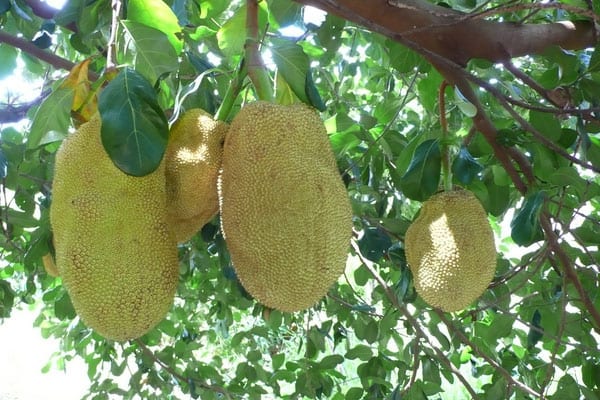This past weekend my son Paul came home to join us for our 40th wedding anniversary. He and his Dad set out to do some shopping for a few basics and a bouquet of flowers for me. While out, they stopped at the local Asian Grocery Store. Thinking I had not made enough food for our planned supper party (!) they decided to buy a Durian and a Jackfruit. Apparently, you can make a vegan pulled pork-like dish using Jackfruit and they were keen to give that a try.
I had prepared lots of tasty dishes for our guests to eat so thankfully they did not start into preparing the Jackfruit until the following day, leaving me to work unobstructed in my kitchen.

The World’s Largest Fruit
The day after the party, knowing nothing about the fruit, I did a little Wikipedia research. I knew nothing about Jackfruit (Artocarpus heterophyllus) except that it was BIG.

It is the largest tree fruit in the world and can weigh as much as 120 lbs. Ours measured about 28″ long – about the size of a big watermelon – I’ve no idea what it weighed. The fruit is attached to a very sturdy stem. Each tree can produce up to 500 fruits making me believe that the Jackfruit tree has got to be a very strong tree indeed. The outer skin is very bumpy but not spiky like a Durian.
The tree originates in southern India but is now grown in Thailand, Taiwan, India, Vietnam, Sri Lanka, Indonesia, Malaysia, the Philippines, Brazil and Africa. It is the national fruit of Bangladesh and Sri Lanka. You can find it in whole like Rob and Paul did or buy it canned in water or syrup or frozen. Many dishes, both sweet and savory, can be made from it including ice cream, custards, cakes, chips, noodles, smoothies and curry. Inside there is a pithy central area and closer to the skin are the seed ‘cells’, separated by more of the pithy white flesh. The yellow/orange seed cells are the edible part.

There are two main types of Jackfruit, one with sweeter softer fruit and a harder variety. Thinking about shipping, I’m pretty certain we had the harder variety. The seeds, with a taste described as like a Brazil nut, can be boiled like Chestnuts, baked or roasted.
Opening the fruit requires a very sharp knife that has been sprayed with cooking oil. It’s almost a two-man job to get the Jackfruit split. The boys did it outside on the patio with me hanging over the balcony edge to watch.

Paul seemed to think that the smell of the fruit reminded him of bubblegum. I thought it was more like vanilla custard. Others think it reminds them of banana or pineapple. At any rate, it has a pleasant, sweet aroma.
With that completed, they decided to split the wealth, each harvesting ½ of the Jackfruit for themselves. Up we went to the kitchen to complete the job. The fruit cells look a lot like a peeled artichoke with a big seed about the size of a small walnut in the center. The seed has an easy-to-remove white shell.
You’ll notice Paul is wearing gloves. That’s because the tree that it grows on, although it does not look like it from the leaves, is an evergreen. The white pithy part has a milky liquid that is so sticky that it takes varsol to remove it from your hands, bowls and utensils. We tried soap and water to no avail. The edible part is fine to touch. In Tanzania, fruit sellers provide small bowls of kerosene for their customers to clean their fingers.
Nutritionally the Jackfruit provides 20% of the daily value of vitamin B6 and it has moderate levels of vitamin C and potassium.
The fruit itself yields about 27% edible flesh and 15% edible seeds. So far we’ve only worked on a bit of the fleshy part. I made a couple of smoothies that were quite delicious.
The wood of the Jackfruit tree is used for building homes and furnishings because it has good grain and is termite-proof. It is also superior to teak for building furniture making me wonder if my Malaysian-made kitchen table that we’ll be eating our Jackfruit pulled ‘pork’ dish on is also a product of this prodigious tree. Could be!



Love your story! I tried some Jackfruit in Mexico and quite liked it. There I was told that it is used with diabetic patients. I wonder if that is true.
Nice, how was it used? I didn’t read anything about it being used for diabetics. Usually things with inulin are recommended for diabetics.